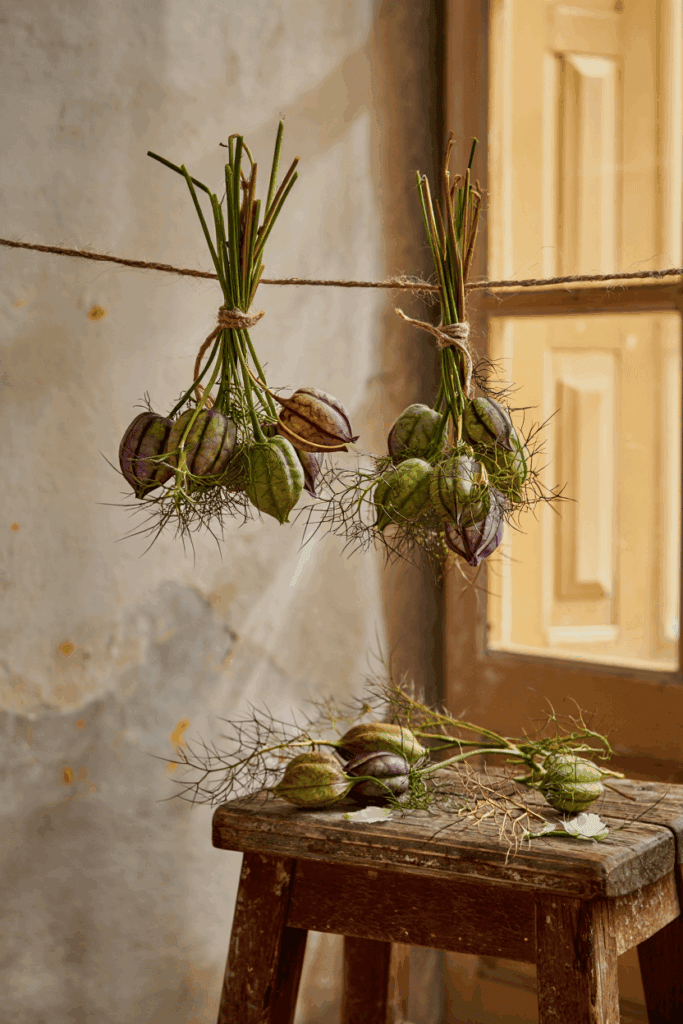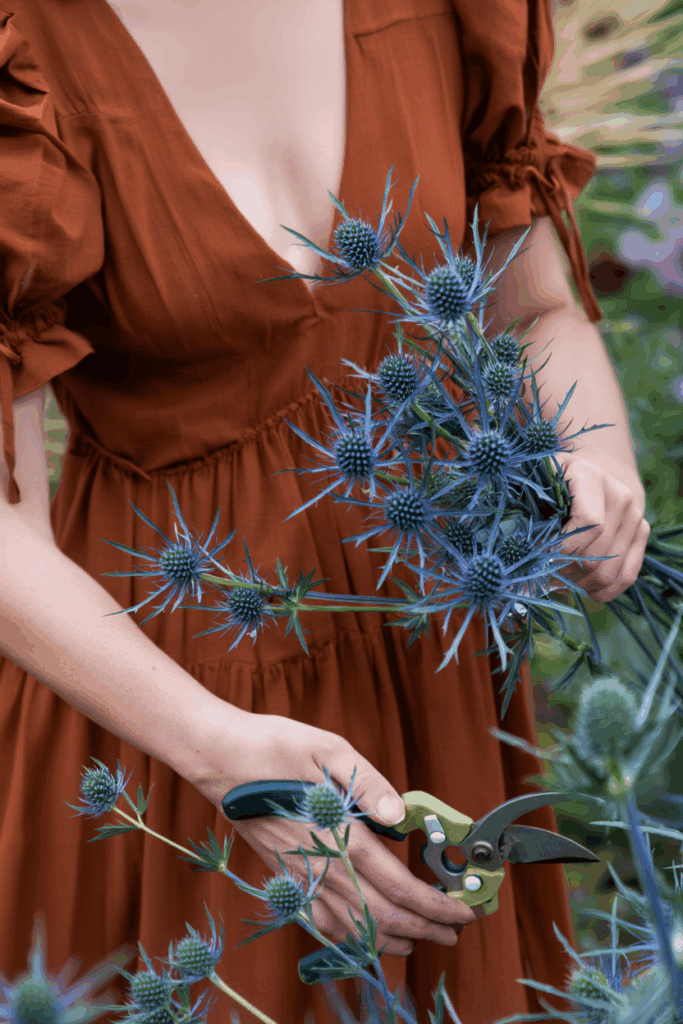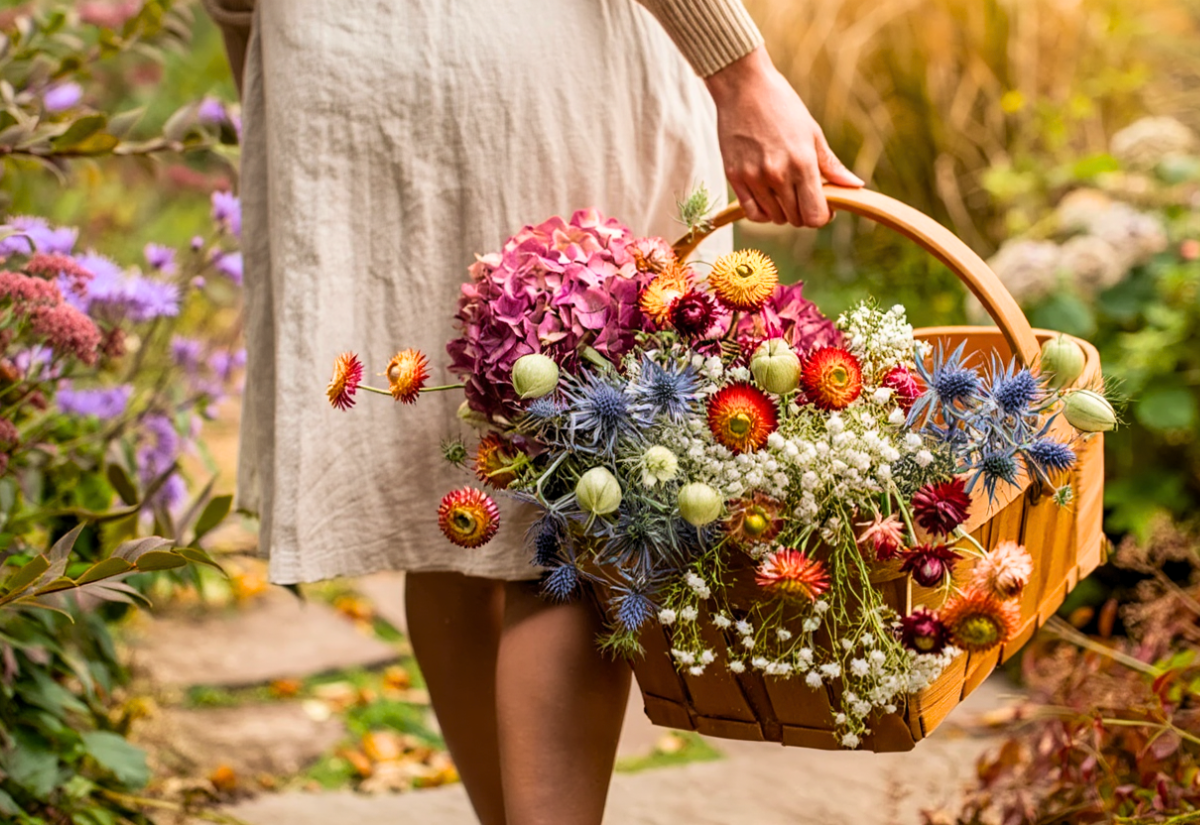The garden feels different in fall. The sunlight softens, the mornings turn crisp, and blooms that once seemed endless now hint at their final curtain call. But this is also the moment I love most — the time when flowers can be gathered, dried, and carried into the colder months like treasures from another season.
Some, like hydrangeas and roses, slip gracefully into their second act, fading into antique tones that look as though they’ve been brushed onto canvas. Others, like strawflowers and globe amaranth, seem made for it — holding their color and shape as if the turning of seasons means nothing at all. And then there are the surprises: seed pods, thistles, and cones that suddenly become sculptural jewels when the petals are gone.
Drying flowers now is like bottling up autumn’s beauty. A handful hung from a beam, a cluster arranged in a jug by the fire, or a wreath ready to welcome guests at the door — each is a small reminder that the garden keeps on giving, even when frost has settled in.
Here are ten cottage garden favorites that shine brightest when harvested in September and October. Take them now, while the window is open, and you’ll have beauty that lasts not just for weeks, but for seasons to come.
1. Roses (Rosa spp.)
No flower says “cottage garden” quite like the rose. In peak summer, they fill borders, trellises, and archways with romance and fragrance. But as the season shifts, roses carry their beauty indoors — their petals drying into antique shades of blush, ivory, and burgundy that look like they were plucked from a still-life painting.

For drying, timing is everything. Harvest blooms in late summer to early fall, just before they’re fully open — petals at three-quarters unfurled hold best. Always cut in the morning after dew has evaporated, when stems are hydrated but not wet. Strip all foliage (it browns and molds), then gather in bundles of no more than five stems. Hang them upside down in a dark, dry space with steady airflow — an attic, closet, or shed works well if humidity stays under 60%. Avoid kitchens or greenhouses where moisture lingers.
Depending on thickness, petals cure in two to three weeks. Thicker old-garden roses may take a bit longer than hybrid teas. Once dried, use them in wreaths, garlands, or simply clustered in a rustic pitcher. Their papery texture and muted tones are at their most evocative in autumn and winter arrangements.
Even after the garden has gone quiet, roses remind us that beauty doesn’t end with bloom time — it transforms.
2. Lavender (Lavandula angustifolia)
If there’s one plant every cottage garden deserves, it’s lavender. The silver-gray foliage, the purple spires in midsummer, and the fragrance that lingers on your hands long after brushing past — it’s a plant that never stops giving. Even as the garden quiets down, lavender offers a second life indoors, where its blooms dry beautifully for sachets, wreaths, and everlasting bouquets.
By October, in many regions, the main flush is long gone, but a second, lighter bloom often appears. This late flush is ideal for drying — flower heads are smaller, but the oils are more concentrated. Cut stems when half the florets on each spike are open; too early and they shrink, too late and they shatter. Morning harvest, after dew has lifted, locks in both color and scent.
Gather 8–10 stems at a time, strip most of the foliage, and tie with twine. Hang upside down in a dark, airy spot (a garage or north-facing shed works well) where the temperature stays below 75°F (24°C) and humidity under 60%. Within 10–14 days, the spikes will be papery-dry but still fragrant. Once cured, keep them intact for arrangements or crumble the florets for potpourri, sachets, or bath salts.
Come midwinter, when the garden sleeps, one brush past a jar of dried lavender can release the memory of high summer — sunshine, bees, and warm breezes captured in scent.
3. Strawflower (Xerochrysum bracteatum)
If ever a flower was made for drying, it’s the strawflower. Even fresh on the stem, its petals feel like parchment — crisp, light, and already halfway to preserved. In shades of yellow, orange, rose, and ruby, they bring the warmth of summer straight into winter arrangements.

The secret is timing. Cut strawflowers when the blooms are two-thirds open, with the inner petals still cupped toward the center. Harvest too late and the petals curl backward as they dry, losing that perfect dome shape. Remove leaves and tie stems into bundles of 10–12. Hang them upside down in a warm, well-ventilated place out of direct sun. They’ll dry quickly, usually within a week, and keep their vivid color for months.
For the best results, grow them in full sun and lean soil — too much fertility produces lush foliage but weaker stems for drying. Once dried, strawflowers can be wired onto wreath bases, tucked into bouquets, or left in simple jars where their colors glow against the muted tones of winter.
Strawflowers are the everlasting heart of a cottage bouquet: rustic, bright, and full of charm long after the garden has faded.
4. Nigella (Nigella damascena)
Better known as love-in-a-mist, nigella is every bit as whimsical in seed as it is in bloom. The flowers may be fleeting, but once they fade, the garden gives way to balloon-like pods streaked with green, rose, and ivory — sculptural little lanterns that bring texture and intrigue to dried arrangements.

For drying, timing is key. Harvest pods in late summer through early fall, when they feel firm to the touch and show their marbled streaks, but before they become brittle. Cut with a length of stem attached, then either bundle and hang upside down in a dry, shaded place, or stand them upright in an empty vase to air-cure. Both methods preserve their shape, though hanging prevents any bending of stems.
Once fully dry — usually within two to three weeks — nigella pods retain their airy silhouettes and muted hues for months. They’re striking on their own in a tall pitcher or woven into wreaths where their spiky crowns add a wild, natural rhythm.
Nigella reminds us that a cottage garden’s story doesn’t end with petals. Sometimes, the after-bloom is the most enchanting chapter of all.
5. Hydrangea (Hydrangea macrophylla, H. paniculata)
Hydrangeas are the grand dames of the cottage garden, and in autumn they transform into some of the most breathtaking dried flowers. Their billowing mopheads and airy panicles shift from summer brights to antique shades of jade, blush, parchment, and bronze — colors that seem painted by time itself.

The best stems for drying come in September through early October, when petals feel slightly papery and tones have softened from vivid to muted. Cut stems with strong branches, strip most of the foliage, and stand them upright in a vase with just an inch of water. As the water slowly evaporates, the blooms cure in place, keeping their full shape and subtle, painterly hues.
For the most reliable results, grow hydrangeas in rich, evenly moist soil with morning sun and afternoon shade; stress often leads to browning petals that don’t dry as cleanly. Once preserved, the blossoms are stunning on their own in tall pitchers or woven into wreaths and garlands, lending arrangements a sense of vintage elegance.
6. Globe Amaranth (Gomphrena globosa)
Globe amaranth may be small, but it shines like cut crystal in the drying room. Its clover-shaped blooms — magenta, coral, orange, and snowy white — hold their jewel tones exceptionally well, refusing to fade even in midwinter.

Cut flowers in late summer through frost when the blooms are fully open but still tight and vibrant. Strip away foliage, then hang stems upside down in loose bundles in a dry, shaded space with good airflow. Within 10–14 days, they cure completely, keeping their cheerful button-like form.
For the best stems, grow globe amaranth in full sun and lean soil; too much fertility produces weak growth that doesn’t dry as cleanly. Once ready, the flowers slip easily into wreaths, garlands, or clustered mini-bouquets where their jewel tones bring brightness to otherwise muted palettes.
Globe amaranth proves that sometimes the tiniest flowers make the boldest statement — a splash of color that carries summer joy well into winter.
7. Gypsophila (Gypsophila paniculata)
Gypsophila, better known as baby’s breath, is the soft veil every dried bouquet seems to need. Its clouds of tiny white blossoms keep their airy form after harvest, adding lightness and movement that soften bolder flowers. In a dried arrangement, it feels like a whisper of summer preserved.

Harvest stems in late summer through early fall, when most florets are open and still bright white. Avoid cutting once the blooms begin to brown. Strip excess foliage, then hang bunches upside down in a cool, shaded place with good airflow. Within 7–10 days, the sprays cure to a papery texture while keeping their airy fullness.
For the best drying stems, grow gypsophila in full sun and well-drained, alkaline soil — conditions that encourage sturdy branching and abundant flowers. Once dried, the sprays weave easily into wreaths, garlands, or simply tucked into jars, where their softness brightens even the darkest corner.
Gypsophila proves that in both fresh and dried form, sometimes it’s the quietest flowers that make the arrangement whole.
8. Statice (Limonium sinuatum)
If you’ve ever come across an old-fashioned dried bouquet still holding its color after decades, it likely included statice. A true “everlasting,” statice produces clusters of papery blooms in violet, white, lavender, and blue that retain their brilliance long after harvest.

For drying, harvest in late summer to early fall, when flowers are fully open but the stems remain firm and upright. Avoid cutting once stems start to soften — they’re more prone to drooping. Gather small bundles of 6–8 stems, strip excess foliage, and hang upside down in a dry, dark, and well-ventilated space. Because statice petals are naturally papery, they require little curing time — usually 7–10 days.
Once dry, statice excels as a filler: sturdy enough to anchor wreath bases and long-lasting enough to brighten arrangements through winter. In the cottage garden, it’s the dependable workhorse — never showy, but always steadfast, in bloom and beyond.
9. Yarrow (Achillea millefolium)
Few flowers bridge garden and vase as gracefully as yarrow. With flat-topped umbels in golden yellow, soft pink, or creamy white, yarrow holds its form beautifully after drying, lending a wildflower-meadow look to arrangements.

Cut stems in mid- to late summer, just before florets begin to fade or brown. If harvested too late, the heads tend to shed. Strip off lower leaves, gather into loose bunches, and hang upside down in a shaded, airy place. Within 10–14 days, the blooms cure to a papery texture, keeping their shape and much of their color.
Yarrow pairs especially well with bolder dried flowers like roses, hydrangeas, or strawflowers, softening their edges with a touch of meadow charm. It’s the kind of plant that brings a lane-side simplicity into the cottage bouquet — unpretentious, natural, and quietly timeless.
10. Sea Holly (Eryngium spp.)
Sea holly is the wild jewel of the cottage border — spiny, thistle-like bracts surrounding steel-blue cones that keep their metallic sheen long after the garden fades. Few flowers add as much drama and structure to dried arrangements.

Cut stems in late summer to early fall, when bracts are fully colored but not yet brittle. Wear gloves when harvesting; the spines are sharp even fresh. Strip the lower leaves and hang stems upside down in small bundles in a dry, shaded spot with steady airflow. Drying takes 2–3 weeks, after which the cones and bracts hold their cool blue and silver tones for months.
Sea holly thrives in poor, sandy soil and full sun, which makes it especially valuable in cottage gardens — easy to grow, drought-tolerant, and stunning when dried. Once preserved, its architectural form pairs beautifully with soft companions like statice, lavender, or gypsophila, lending contrast and boldness.
Sea holly proves that not all dried flowers are delicate — some bring strength and a glint of steel, carrying the energy of summer thistles into the stillness of winter.

